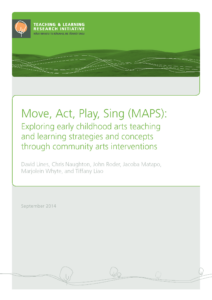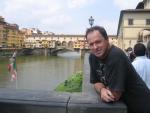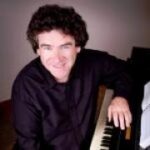Introduction
Move, Act, Play, Sing (MAPS) explored early childhood teaching and learning in the performing arts through community artist interventions and relational practices and pedagogies. The research developed three early childhood centre case studies where teachers, children, and parents worked together with community artists, the research team, and other colleagues to explore emergent pathways of performing arts teaching and learning. In MAPS, community artists in music, dance, and drama worked alongside teachers and children in semi-planned, open, and improvisatory pedagogical settings set up to explore the potentialities of performing arts learning and teacher responses in the centre environments and communities. The ethnographic inquiry focused on how the early childhood teachers engaged in meaningful performing arts experiences through the research process and looked at ways in which centres could engage in sustainable, ongoing performing arts teaching and learning.
Key findings
- The research design and intentions of the MAPS project gave it a particular focus that assisted community-minded teaching and learning in the performing arts in the case-study centres.
- The project opened up insights into early childhood performing arts teaching in the case-study centres. This included the value of establishing rich connections with parents and the community, the benefits gained from fostering an open/improvisatory pedagogical stance, and the sensitivities and awareness needed to respond to children’s ideas.
- The formation of communities of learning through cluster days and community artist visits to early childhood centres created a responsive environment for teacher-practitioner inquiry and confidence in the performing arts. This provided a platform where change could be embraced, discussed, and questioned and assisted in the sustainability of the programme.
- The MAPS project brought a level of reflexivity to performing arts teaching and learning in early childhood that enhanced the connectedness of arts experiences with centre environments, parents and the community.
Implications
- Performing arts teaching and learning can benefit from carefully designed community-based approaches to knowledge and practice development.
- Alternative community frameworks, such as those developed in the MAPS project, assist in revitalising and reconceptualising performing arts teaching and learning.
- Performing arts teaching and learning in early childhood can be enhanced through relational, open, and emergent pedagogies that stimulate and foster connections and links with centre contexts, environments, cultural meanings, and expressive actions.
Introduction
Move, Act, Play, Sing (MAPS) was an exploratory early childhood research project in performing arts teaching and learning. The aim of the project was to nurture a supportive, relational performing arts environment and document emergent concepts and learning pathways in the performing arts in the three case-study early childhood centres. Each centre developed pedagogical concepts, strategies, and experiences with a visiting community artist for 3 months at a time in the performing arts of music, dance, and drama.
Recent research in children’s arts education in New Zealand (Fraser, Price, & Aitken et al., 2007; Naughton & Lines, 2013; Pohio, 2009; Sansom, 2011) has explored child-initiated, cultural, holistic, and relational notions of arts teaching and learning. For teachers and children, this research suggests that different arts practices denote different forms of agency, thinking, and responding. Music, dance, and drama in this sense give opportunities for diverse means of creative expression with musical sound, imaginative storying, play, language, movement, and gesture in a wider community context. With this in mind, we became interested in finding out if early childhood teachers and their communities could benefit from the performing arts in terms of its relational value and broad means of expression through meaningful community-minded performing arts practices.
The study was developed with a team of participants consisting of principal researchers, research assistants, community artists in music/dance/drama, centre managers, teachers, and centre whānau/parents and children. Central to the research team were the teachers, parents, and children of three early childhood centres in the greater Auckland region: Helensville Montessori, St Andrew’s Epsom Early Childhood Centre, and Te Puna Kōhungahunga in Mt Eden.[1] While each centre had its own distinct philosophical directions and practices, each acknowledged they had an interest in the arts and an affinity with Reggio Emilia philosophy and practice. At the beginning of the research the teachers were enthusiastic about the project and the prospect of learning about music, dance, and drama, yet at the same time apprehensive about the skill set demands of the performing arts and what might be required of them in terms of specific skills and knowledge.
The research
As a community-minded research project, MAPS drew from the view that community-focused education, including education in the performing arts, offers a practical and meaningful alternative to individualised, consumer-driven early childhood education (Dahlberg & Moss, 2006, p. 2). The meaningful and valuable aspects of a community can inform a deeper sense of pedagogical value. This is particularly evident in the arts, which offer opportunities for teachers and children to engage in and respond to their community contexts and environments in a variety of ways. Although MAPS was not a Reggio project as such, we drew inspiration in part from the cultural movement of the municipal schools of Reggio Emilia, where the experiences of children are seen as valuable and ethical encounters, dialogues, connections, and interactions within the public space of the community (Dahlberg & Moss, 2006, p. 2). The search for strategies and pathways to help children find meaning through their encounters and experiences is central to the concerns of the Reggio movement (Rinaldi, 2001, p. 79), and we saw a link between this and our own concern with helping teachers—and their children—find community meaning in performing arts experiences. We were also interested in the notion of the pedagogy of listening, of a developing sensitivity to the many ways we could listen to the embodied thoughts and ideas of children (and teachers) through multiple means, such as those afforded by the performing arts. This was “listening as sensitivity to the patterns that connect, to that which connects us to others” (Rinaldi, 2001, p. 80), which we interpreted as a community-focused sense of awareness, receptivity, and difference. This was well documented in visual arts expressions of community in the Reggio literature, and we intended to develop it further, in the performing arts context. In addition we saw that the Reggio Emilia practice of pedagogical documentation (Dahlberg, 2012) was an excellent example of how emergent pedagogical events and knowledge could be “mapped”—a place where research and practice could meet as a cartography of ongoing change, direction, and intensity through learning. This helped us see the performing arts not just as a set of different disciplines, but as different community assemblages of linked action and expression. This perspective and approach also had a synergy with the early childhood curriculum Te Whāriki (Ministry of Education, 1996), which de-emphasises subject disciplines and advocates for a wider sense of belonging and community in learning.
A key aim of MAPS was to build a community of learners with the research participants through experiences and pathways triggered from provocations in the performing arts. This was inspired also through recent early childhood research that promoted a greater awareness and understanding of space, place, and sustainability through an ethic of care and relationality. Ritchie’s (2012) study of indigenous relationality, of “both living and non-living elements in our environment”(p. 86), helped us position the research not only as an exploration of performing arts through social interaction but as a practice of care for the different elements and connections that came into play through performing arts experiences. Similarly, Duhn’s (2012) work showed us how teachers and children worked with a changing and mobile sense of place and space in the early childhood centre, and we began to see and hear these changing elements with the performing arts experiences and events in the project.
With an aim to provoke and problematise performing arts teaching and learning and also nurture and care for it in the centres, we engaged three community artists (music, dance, drama) to work alongside teachers with children in both planned and unplanned sessions. The idea of using a community artist as opposed to a teacher educator or professional development facilitator was to help stimulate the idea of community in performing arts experiences and de-emphasise the idea that the teachers were doing this to help the children “consume” some kind of curriculum outcome. Creative people are known to have a “passion for their work” (Csikszentmihalyi, 1996, p. 72), and it was hoped that the community artists, as artists, could bring this passion to the interaction that could be valuable for the teachers—who could begin to see themselves as passionate enablers of performing arts experiences with the children. The idea was to nurture performing arts possibilities and experiences afforded by each community environment enhanced through the research process. The community artists were “provocateurs”, who served to stimulate and provoke connections of interest, and the act of bringing in a community artist into a centre helped the teachers to look at their own immediate communities as a source of arts provocation and meaning.
Research aims and questions
The main research questions in MAPS were:
- What connections and links form in the process of building performing arts experiences with community artists, teachers, parents, children, and their environments?
- What emergent learning strategies and pathways do teachers, children, and others adopt from the performing arts interventions in the case-study early childhood centres?
- How do centres sustain and develop performing arts experiences for children using the centre environment and the community in the community event?
- How does the research process, methodology, and project experience contribute to the centre teachers as practitioner-researchers in performing arts education?
Methodology and analysis
The research was an arts-based qualitative inquiry that employed ethnographic research techniques. Qualitative ethnographic research seeks to develop and document descriptions and perspectives of cultural events through observation, interviews, and documentation of cultural interactions in their natural settings (Bresler, 2010/1995). The specific cultural and community settings of the three participating early childhood centres formed a backdrop for the inquiry. Each centre participated in performing arts experiences and provocations through: (i) a visiting community artist (one term each of music, dance, and drama) who negotiated performing arts experiences with children and teachers, and (ii) Saturday cluster day workshops in the performing arts where the teachers from all the centres met together with the artists and researchers for workshops in the performing arts and for in-depth discussion. The research in this sense was also a practice-based intervention. At the conclusion of the project each centre prepared and presented a special community event, with the children engaged in performing and making arts along with teachers, parents, whānau, and the visiting community artists.
A wide range of data was collected through various media including:
- teachers’, researchers’, and community artists’ comments and dialogue through Moodle, an online environment set up for the project
- video data of teachers and children engaged in performing arts sessions, made available to participants through Moodle for viewing and commenting
- audio transcripts of teacher/community artist interviews and cluster day group discussions
- researcher observations and descriptions of events (from live observation and video sources)
- meetings between principal researchers (minuted); between research assistants and principal researchers (audio recorded and transcribed); and between research assistants and community artists (audio recorded and transcribed.
As the MAPS project developed it became apparent that we needed fresh theoretical and philosophical thinking to assist our reconceptualisation of teaching and learning performing arts in early childhood education. Following the work of early childhood researchers Olsson (2009), Lenz Taguchi (2010), and Sellers (2013) we found immense value in the work and writing of Deleuze and Guattari (1987). These perspectives had a resonance with our own research project in early childhood performing arts. Deleuze and Guattari assisted in our understanding of the multidimensional and complex world of early childhood education and gave meaning to new concepts that helped us express what was happening in and between groups and events in the project. The directions, pathways, and spin-offs that emerged from the research process were seen as a “rhizome”, which has “neither beginning nor end, but always a middle (milieu) from which it grows and which it overspills” (Deleuze & Guattari, 1987, p. 21). By thinking about the research process, performing arts provocations, and teaching and learning in this way, we were able to consider which pathways were emerging from the middle of the interactions and the possible directions they offered. The moments of “crystallization” (Ellingson, 2009) were of particular interest to us, where activity became more intense with gathering interest and movement—and where multiple ways of knowing presented different “diffractions” (Richardson & St Pierre, 2005). Following a review of the data, a selection of examples of practice—stories, vignettes, and descriptions—were chosen by the researchers to present the polyvocal (Sanger, 2003) responses and emergent arts-based pathways of the teachers involved in the project.[2] We suspect that the specific nature of the research intentions led to many of the interesting developments in community-inspired performing arts teaching strategies and practices.
The three case studies
Helensville Montessori is a 16-year-old semi-rural early childhood centre in the satellite town of Helensville, north of Auckland city. The centre has 16 teachers, all of whom were involved in MAPS. There are currently 124 children enrolled in the centre, 50 percent of whom live in Helensville, and 50 percent out of town in the immediate rural area. The centre describes itself as having:
Core Montessori curriculum and beliefs (respect for children and what they are capable of; independent children in charge of their own learning) appropriately reconceptualised for Aotearoa in 2014; influenced by Reggio Emilia; delivered within our own Te Whāriki framework. Reflective practice; self-review; action research [is] expected of [the] teaching team; supported and encouraged by strong collegiate relationships and [a] well-resourced environment. (personal communication, 15 April 2014)
Te Puna Kōhungahunga was opened 10 years ago on the grounds of what is now the Faculty of Education of the University of Auckland. it is a Māori-medium early childhood education centre that provides quality learning experiences for ngā mokopuna. it has a roll of 56 mokopuna aged from 10 months to 5 years and nine kaiako. The 45 whānau are a combination of students and staff of the university and members of the wider community who want this particular kaupapa. Te Puna uses te reo me ngā tikanga Māori for all teaching and learning experiences. The degree of fluency in te reo Māori varies from fluent speakers to beginners amongst the kaiako and the whānau. Everyone uses as much te reo Māori as their ability allows to provide the teaching and learning experiences throughout the day. Their philosophy is captured in the folllowing whakatauki:
Whangaia te manu o te ngahere ki te miro, nana te ngahere.
Whangaia te tamaiti ki te matauranga, nona te Ao!
Feed the bird the fruit of the forest and it owns the forest.
Feed the child knowledge they own the world.
Following this ethos they state:
We intend our mokopuna to leave the Puna to be able to walk confidently in both the Māori and wider worlds. (Personal communication, 24 April 2014)
St. Andrews Epsom Early Childhood Centre has been established for 13 years. it is set in the heart of “leafy” Epsom and serves the immediate district as well as families from surrounding districts. There were four full-time teachers who were all involved in MAPS. up to 25 children participate in the centre each morning and afternoon. St Andrews is a small private centre, which is licensed for 25 children. Although it has a full-day license, most of the 80+ children attend on a sessional basis two or three times a week. The programme is play-based and influenced by the approach in the Reggio Children centres in Reggio Emilia, Italy. All teachers are qualified and registered. The centre adds:
Our point of difference is our strong visual arts culture that has developed over the years due to the interest of the staff and management. We have a very supportive parent community. Many of our children are from professional families with one parent working full time and the other either working part time, or fulfilling the role of full-time caregiver. (Personal communication, 17 April 2014)
Case-study responses to the intervention were categorised according to the focus areas implied by the research questions. While the researchers found many synergies between categories, selections of teacher responses are recorded below to aid reader appreciation of the project.
Findings
The MAPS project demonstrated that many positive teacher and learner benefits could be found arising from community artist interventions and other aspects of the project. These are highlighted in the following descriptive accounts of selected responses of project participants, taking into account the focus areas of the research questions.
The research process: Building community through performing arts
As a research project, MAPS offered the centre teachers an opportunity to be involved in community-building performing arts and reflective research experiences. The different interactions between participants during the research allowed teachers to develop their knowledge and understanding of the performing arts as a community research team, with the community artists, and in the centres with children and parents. This came about, in part, through the research interventions that were implemented over the course of 1.5 years. These included: bringing community artists in music, dance, and drama into centres to act as interveners for performing arts development (this was rotated on a term-by-term basis); cluster days, held once a term on a Saturday, which brought all research participants into one space to develop performing arts ideas together; and through online materials and a discussion blog (Moodle) that fostered the sharing of ideas between the teachers, artists, and researchers during the course of the project. Pedagogical ideas and strategies emerged from the community artist visits to centres that added to the community building, such as: finding special spaces for performing arts, encouraging exploratory performing arts experiences, sharing children’s ideas, teacher/artist responding to children’s ideas, and allowing other interested children (watchers) to participate. In and around all these happenings, reflective discussions between teachers, researchers, and community artists contributed to the development and shared understanding of the project as a whole.
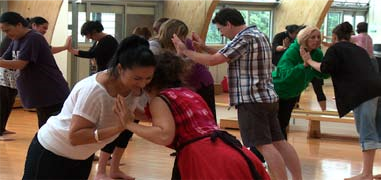
Cluster day dance workshop
These collective events inspired the teachers to actively participate in the project. Fale, a teacher at Helensville Montessori, got inspiration and benefit from the knowledge and passion of the community artists. Community artist workshops on cluster days inspired her to enter further into sharing, discussions, and networking and set the scene for community artist visits in centres. Writing on the research Moodle, Fale shared the following:
Talofa everyone I hope you all had a great week and the PD experience with the dance, drama and music artists on Saturday was overwhelming and I felt really inspired about how these artists demonstrated their wealth of knowledge and passion in what they love to do … I came to the workshop not knowing what to expect but got so much more out of this whole experience. I am so excited and look forward to share discussions and networking with everyone who is involved in this project. (8 May 2012)
Right from the beginning of the project, Fale, like many of the other teachers involved, saw MAPS as a positive intervention and expressed a willingness to get involved in the various experiences. The interventions and community opportunities in MAPS enabled her to enter into performing arts learning as a centre teacher, acknowledging the value of not only her own involvement, but the openings afforded through connections with other teachers, the community artists, and the research team. The research process created a responsive environment for teacher–practitioner inquiry and confidence in the performing arts. The many posts and discussions on Moodle allowed the teachers and researchers to engage in thoughtful, reflexive dialogue about performing arts teaching and learning in early childhood.
Creating a space for the performing arts
Kirsten, the music community artist, had six weekly morning sessions at Helensville Montessori over the course of one term. The centre prepared a “gazebo” in advance of the sessions—this was a space dedicated for performing arts work during the MAPS project which provided a distinctive area for the children to enter into performing arts learning together. In the gazebo a core group of children and teachers were chosen to participate in the sessions. They became a self-made musical community in this special space.
Making musical connections: Kirsten
Kirsten’s music sessions involved children and teachers working with musical materials—sound-making devices—both conventional and unconventional. An experimental approach was encouraged, and children would take the lead and initiate discoveries for themselves. During this process some teachers reported that they became more sensitive to the musical sounds the children were discovering:
… Well you think about music and as you say ‘formally teaching music’ and if you think about teaching music in early childhood we might have done some work with instruments, but mainly, if you think about teaching and early childhood, it might be about rhythm, it might be about singing, it might be about following along to a recent taped music … all of that is still happening, but it’s much more about letting children take the lead and about really listening to them and seeing what sounds … (Centre teacher, Community artist/teacher discussion, 21 June 2012)
In this sense, links were made between the creative qualities of music and sound discoveries and the learning choices of the children as they engaged with the sound devices.
Using the imagination and using improvisatory music stories
Kirsten’s initial provocations with the teachers and children invited them into an imagined and creative space:
I’ve brought in some things that they will then take away and possibly create their own. I imagine that room to be a sound installation. I imagine it to evolve each week depending on what the children find and do… (Kirsten, Community artist/teacher discussion, 10 May 2012) in the first few sessions Kirsten presented new sound sources through crafting an improvised story with the children, inviting new forms of response. Following this, the children began to explore the room, which had different sound sources stationed around it. This opened up a more intense session of individual and group play with considerable movement and action. In one session a 4-year-old girl approached a row of colourful bottles filled with materials that sounded when the bottles were shaken. She sounded and rearranged the bottles on a table, quickly moving from one bottle to the next. Another girl watched her closely but did not move the bottles. She was equally intense in her participation as an observer. An important aspect of this experience was the inclusiveness afforded to players, watchers, and listeners.
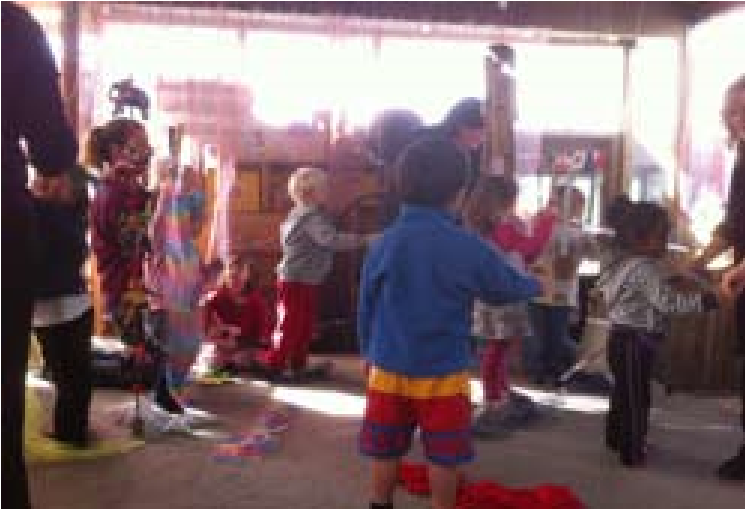 |
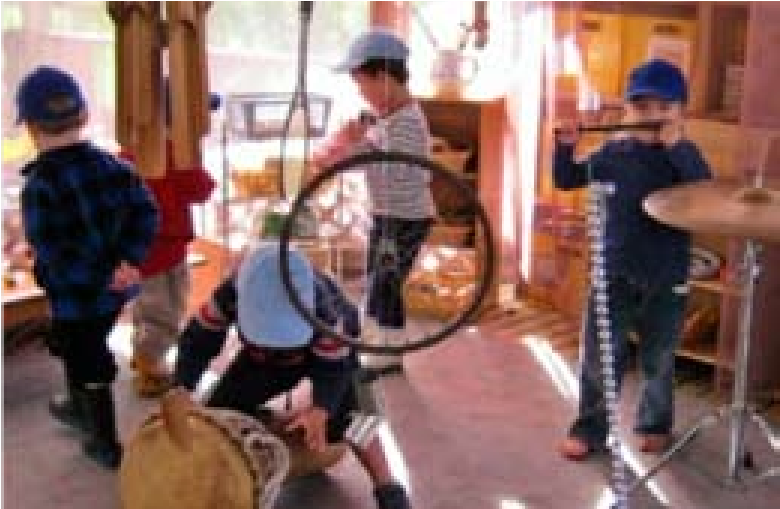 |
Sound discoveries
Creating connections and links: Ripple effects and gifts
For Kirsten “music is a gift” (Kirsten, Community artist/teacher discussion, 21 June 2012)—it is something to be offered and passed on—and in MAPS the act of giving became a pedagogical process. The researchers observed this in Kirsten’s sessions (in all the participating centres), through a moving of musical ideas and gestures between Kirsten, the teachers, and the children. it began with Kirsten initiating the session with the sound-source provocations and moved to the children through invitations of exploratory play. Musical ideas and suggestions then returned to Kirsten, but in a different form, becoming a dialogue between teacher and child. We likened what occurred to the Reggio concept of a pedagogy of listening (Rinaldi, 2001); that is, a sensitivity to action and response and dialogical music sharing that became apparent throughout the project not only in music, but in dance and drama too.
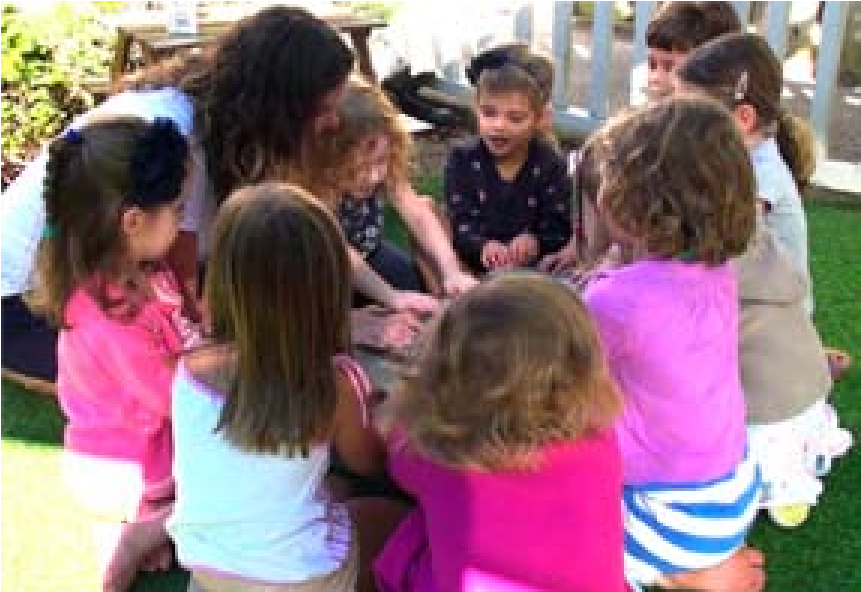 |
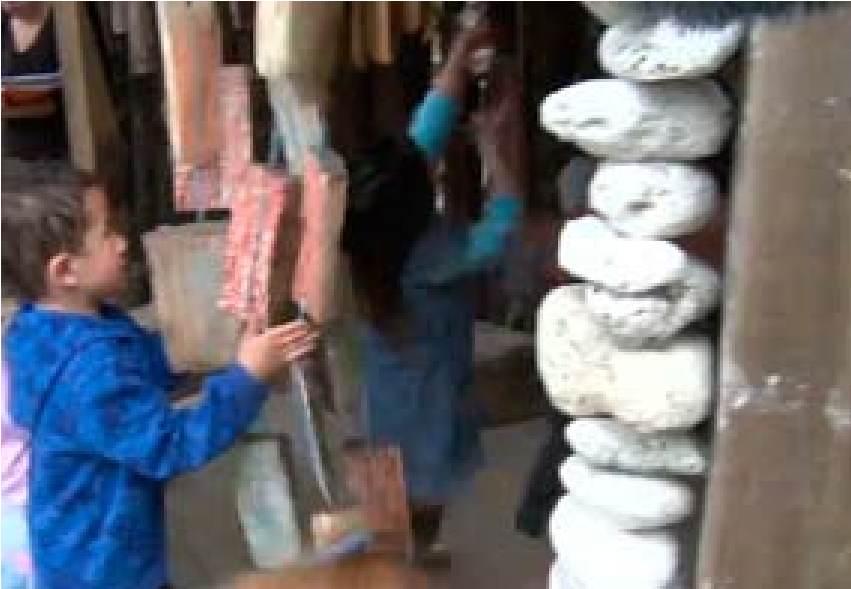 |
Sharing sound ideas at St Andrew’s Sound Garden, Te Puna
Kirsten’s sessions were seen as provocations that would eventually ripple out from this group to the rest of the centre. This idea was articulated as such:
Well it’s the ripple effect of everything and that’s how we see [it] … What worked was the community artists coming in [and] having them work with the same group of children and teachers … so they came in and that meant they could build on what they’d done the week before. We didn’t try and include everyone, we just had a small group of children and teachers and so it was intense, that was the group of core protagonists … it’s a Reggio concept.
The group [started to] then work with the wider group so that’s the ripple effect … but it spreads out so that whole of the centre is involved. (Helensville Montessori teacher reflection group interview, 19 December 2013)
The ripple effect generated by the core group started to affect the watchers—another group of children who were showing spontaneous interest in what was happening. Kirsten noticed these extra children too:
I was impressed with the watchers who actually hung in there the whole time. (10 May 2012)
The teachers were also aware of this and interpreted the involvement of watchers as a process of giving over of pedagogical power:
… when you send your adventurers off to find sounds … watchers might well be going with them because you’re going to take them and don’t forget we want them to go on their own. it’s about giving it to the children … (Centre teacher interview, 10 May 2012)
Emergent learning pathways and strategies in dance: Adrian
The dance sessions with the dance community artist, Adrian, also involved a strategy that worked with ideas initiated by children’s responses. Adrian had a very open definition of dance defined by him as “…any sort of movement that has an expressive intent” (Adrian, Community artist group interview, 13 November 2013), and this way of understanding dance favoured a more open style of pedagogy.
Adrian enabled a form of dance to emerge that expressed what was important to the children and their lives. To action this he developed a flexible pedagogy that consisted of letting the children come forth with movement suggestions and ideas from which he would affirm and encourage other children to follow. This was reflected in the structure of the lesson and the way in which movements were initiated, as commented on by one St Andrew’s Epsom Early Childhood Centre teacher:
It was interesting dancing with Adrian, it was a different style of dancing not just pat-a-cake—[it] felt quite exciting—the moving to the music, how the children related to him not having to be leader—no beginning, middle, and end. (Teacher reflection interview, 14 March 2014)
One sequence began with a well-known circle game that the children at St. Andrews played many times, which was observed by Adrian, who also participated as a player. Within a circle formation, a game started that consisted of making a sound and movement to be copied by the rest of the children. Adrian began by raising up his hand in a swooping motion while making a soft “whoop” sound. The others faithfully copied and then the child to his right made the next movement/sound. Following this, another child suggested they “become” racing cars. A new phase of game began and a fracturing occurred of the circle. As the children embarked on their new game of “driving the car” they became aware that the old order of the game had disappeared … there was no more circle, no more turns, and they sensed a shift in power and seem quite delighted at the new focus. one of the boys, Tommy, realised the change and pointed this out to Adrian:
Tommy: Make a circle.
Adrian: Oh no! The circle! What has happened to the circle? … Okay so now we’re in new game, we’ll all go driving around then when you see somebody stop … we all stop!
Adrian starts driving again around the room and stops. The children seem to be aware of this ‘no man’s land’ they are in—but still wish to continue the game. However, what rules are there going to be now and who will make them up? oriel: I know this game, we’ll have to freeze when we stop!
Ella: Yes, like Musical Statues!
Adrian (improvising): Oh this game is like that, except there is no music we stop when we see everyone else …
Sunil: yes but the racing car…
Adrian: Okay let’s be racing cars again and make the noises … Remember we all stop when someone stops (he speaks as he comes to a halt as do the children). What shall we be this time?
Children: Fishies!
Adrian: Okay let’s be fishies and we’ll make fishy noises. (Adrian continues with his hands joined to mimic a fish as he and the children make fishy sounds) (St Andrews Epsom Early Childhood Centre, 13 August 2012)
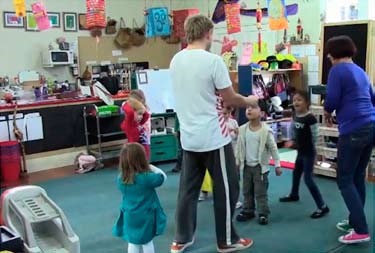
Adrian described the constant process of negotiation with the children in the online Moodle following this session:
I have to allow myself to be comfortable with working with where the energy of the group is going and not knowing the outcome or always sticking to a certain game or set of rules. Basically being playful and adaptive and continually drawing from the group. (Adrian, Community artist, Moodle, 13 August 2012)
In the above sequence Adrian kept the children’s interest and movement alive through his constant readjustment of the parameters and rules. Through negotiation and improvised response he was able to engage the children in positive, group-initiated expressive movement. This led to what many of the teachers saw as authentic learning, guided by the children—inasmuch as the children owned and lived their responses through an enabling pedagogy. The centre teachers note that this pedagogical approach stimulated interest and involvement in dance from both boys and girls.
Emergent learning pathways and strategies: Honouring children’s “voices”
In the first cluster day the teachers partook in a workshop on storytelling. In the workshop the teachers tried out various improvisatory storytelling strategies and discussed their experiences of how children engage in active storytelling. The teachers felt strongly that children’s story ideas were very real to them and should be honoured. “Children don’t tell a story—they live it!” (Teacher, cluster day, 29 October 2012). For the teachers, the value of the story lay in what it meant for the children. This meant putting aside adult conceptions of a “good story” or “structured story” and giving the children more freedom to live a story for themselves and for the group:
It’s allowing for the children’s voice to come out no matter that the story has no obvious plot … it’s letting the children take control. (Teacher, cluster day, 29 October 2012)
The notion of honouring children’s voices in the performing arts became a strong theme in MAPS. The idea of the children’s voice is well known in early childhood settings, and it took on a new relevance here as viewed alongside a broader pedagogical notion of community.
Emergent learning pathways and strategies in drama: Molly’s helicopter stories
In the centres the drama community artist, Molly, expanded this idea of the “child’s voice” and developed it through a helicopter story[3] in which the children acted out their own story suggestions within a specified space in the centre. This strategy involved preparing a rectangular space on the floor with masking tape that would become a “stage” for enacting the children’s stories. Molly would ask questions of the children to encourage story ideas and then suggest they create it for the other children to see.
Molly explained to the teachers how they might use the helicopter story strategy in their centres:
Mark the stage, tell and act a couple of stories that are already told, the ones I used or ones you have from other children to set up this process. Then model the taking of a story with one or two children in front of the others so everyone sees what this involves. Then let the children know that they can come and tell you a story at any time (or set a specific table/area/time for telling). Then, throughout the day you can collect stories and, on the same day they were collected, find a time to bring the children all together to hear them read and to act them. (Molly, Community artist, Moodle, 15 November 2012)
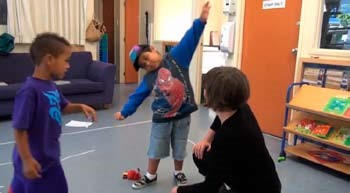
This drama experience promoted the idea that the teachers and children could follow a creative pathway that was right for them. one teacher likened this process of hearing and seeing children’s stories to a sense of community ownership:
I feel this is a celebration for children, of teachers, and the wider community. This is Reggio, a celebration of the project, there is no right or wrong, we go down a pathway that is right for us! (Cluster day, 29 October 2012)
The project as it evolved was very much about the children, teachers, and parents together—the pathway of performing arts learning became a community experience expressed through shared ownership. The learning pathways tended to be improvisatory in that they depended on a responsiveness to the evolving interest and movement of the group.
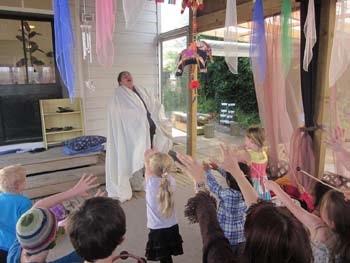
Giving themselves “permission”: Teachers learning to partake in the performing arts
In order to get themselves into a space where they could be more responsive, the teachers had to learn to give themselves permission to participate in the performing arts in a way they might not normally act as part of a group. This process of “giving permission” was an important development in the cluster day workshops:
Giving themselves the permission to participate was interesting. I remember Karen saying: ‘I’m not doing that’ then she was, ‘okay I’m just going to do this,’ then it was ‘Look at me … I don’t do this but I going to do this in the dance.’ I think that was lovely because the cluster days somehow gave them permission to do something, which they obviously didn’t feel they could be a part of normally. (Molly, Community artist group interview, 15 November 2012)
Sustainable practices: Parent events
The concept of sustainability was very important in MAPS, as the researchers wanted to see whether the teachers, parents, and communities could begin to sustain their own performing arts initiatives through community action. Sustainable practices included parent sharing events and the community events that each centre planned and held at the conclusion of the project.
A parent evening was held at Helensville Montessori one evening, following a series of dance sessions with the children during the mornings. The evening was designed to inform the parents and families about MAPS, and allow them to ask questions and participate in dance so they could begin to experience what the children were doing at the centre during the day.
Adrian, the dance community artist, gathered all the willing parents in a circle and began by inviting them to try certain movements together in a similar way he did with the children. He described his intentions:
I started with the circle and just isolating movement in different ways (eg: circles, straight lines, different sizes, speeds) through different body parts and asked for ‘qualities’ or images to evoke ways of moving those body parts from the parents too (eg: cloudy, rigid, jelly). We then paired up or got into threes and did the exercise where one person conducts with their hand and the other interprets with full-bodied movements. We finished with some tableau work (stillness) and asked the brave few volunteers to make connections, change them, change levels, change directions, and so on and see how a dance of sorts emerged from there. I was keen for them to get the idea that the work is emergent, playful, non-prescriptive, there is no right or wrong, and that my sense of dance is a very broad and inclusive definition embracing any expressive movement. (Adrian, Community artist, Moodle, 15 May 2013)
This approach with the parents was similar to what Adrian was doing with the children and teachers in previous weeks. His aim was to bring them into a space where they could offer movement ideas through the “toolkit” he offered and beyond:
I just want to use the toolkit I’ve got to facilitate and to provide them with the idea that they can generate movement and they can offer ideas. I sort of try and set that up right from the beginning. okay … what body part can we do next …? (Adrian, Community artist, Moodle, 20 March 2013)
The parents were an enthusiastic bunch, but some were a little reticent at first. However, the collective presence of the whole group participating together helped ease them into the action, and Adrian became more focused with his movement invitations as time went by. A move into pairs and threes encouraged interaction. The session ended with a still group tableau, and Adrian asked for a volunteer to begin a group sequence of still shapes—each new parent entering the group with an additional shape in response to the group. one enthusiastic mum came forward and struck up an expressive pose. Her gesture was dramatic and without fear and this inspired others to join in with equal enthusiasm, each new parent finding a still space in response to the emerging group shape.
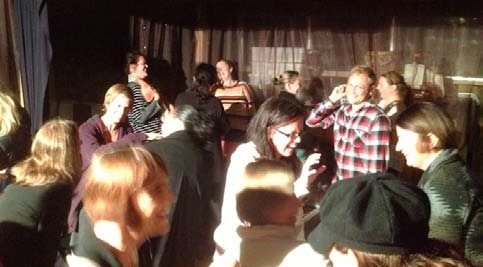
Parents responded with written feedback on the parent evening that gave some indication that making the parent connection was important for their appreciation and understanding of the activity going on in the centre with MAPS:
I found the parent evening delightful to discover some “sense”, suddenly some of the stories my daughter had told me and the movement she had attempted to display for me, made total sense. (Parent, Moodle, 14 May 2013)
The enthusiasm generated by the parent evening was sustained and parents attended morning dance/ movement sessions facilitated by the teachers themselves a few weeks later. one teacher reported on this collaborative experience:
It was a real privilege to work alongside parents in the gazebo over the past week. Each parent had something different to offer. it is great to see the children, teachers, and parents working side by side embracing each other. Leading up to working with the parents in the gazebo it was easy to feel a little nervous, that uncertainty of how the session will go and how the children will be with other adults there. But once there, all the uncertainty vanished. (Moodle, 23 June 2013)
Sustainable practices: St Andrew’s Epsom Early Childhood Centre
At the conclusion of the research each centre held a community event that reflected what they, as a centre, wanted to sustain and develop in the performing arts in response to the MAPS project.
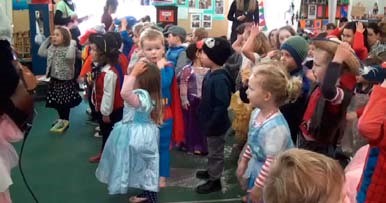
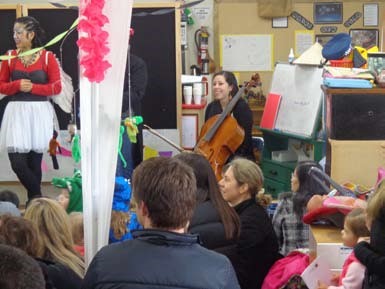
St Andrew’s Epsom Early Childhood Centre held a special music event that parents were invited to one morning. They were keen to develop their music leadership skills and so the teachers prepared a short programme of songs and other experiences. The teachers led on instruments and singing, with one parent, a musician, joining them on the cello. This was followed by an enjoyable story, Hairy Maclary, and a “sound map”, a visual drawing of the sounds in the story, which enabled the children to actively engage in movement, voice, and sound as the story unfolded.
St Andrew’s had a strong interest in visual art in place and this provided an interesting link for them in terms of a more sustained experience of the performing arts. They developed ways in which arts ideas could be represented in different visual forms. The idea of the “sound map” was useful in this regard as it provided a visual means of coming into a musical experience.
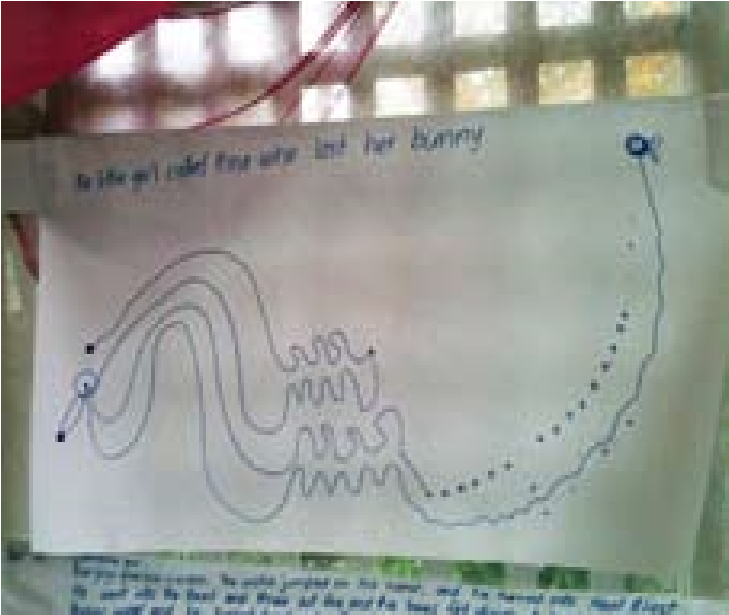 |
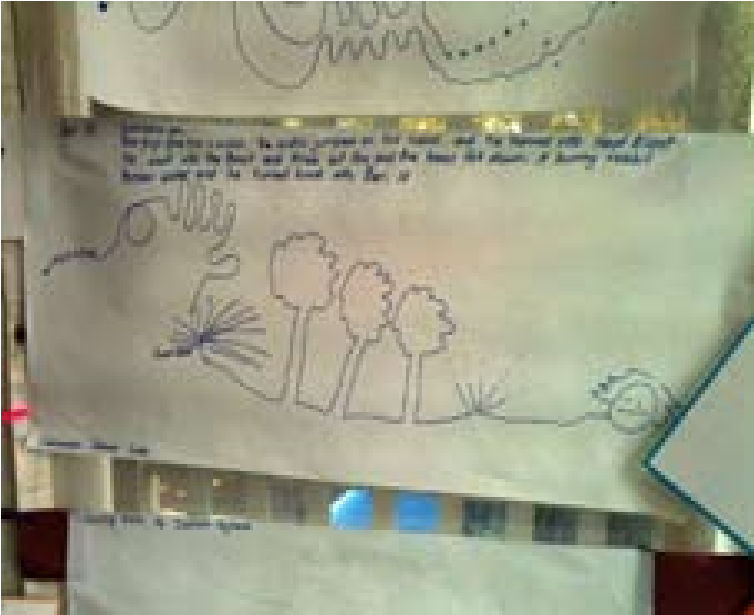 |
Sound maps at St Andrew’s Epsom
The connection with the visual medium carried over into other experiences. In one particular session a boy represented the sounds in “Wheels on the Bus”.
St Andrew’s had some useful thoughts on the coming together of the community artist and the centre. They were keen to reiterate that sustainability in the performing arts came about through spending time with the artist and through the development of creative skills, such as the playing of instruments. In addition, they felt that it was important that there was time for the artist to come to understand and appreciate the particular culture and context of the centre, and for the centre to learn to understand the artist well too. Michelle, head teacher at the centre, commented:
Overall it has been a very challenging project to be involved with, one that shows the potential a community artist regularly visiting the centre can have on children, teachers, and the centre community. To reach full potential I think there needs to be a good relationship with the artist before starting with the centre—with a shared understanding created of the culture of the centre and the culture of the artist. (Moodle, June 2013)
Sustainable practices: Te Puna Kōhungahunga hikoi
‘Watch out for the flames’ called out the kuia as the tamariki ran eagerly to join in the events building energy in the grass away from ngā kaiako. In the events unfolding there weren’t any flames in the sense that one first imagines hearing this cry, and the kuia who stood amidst the long grass pointing to places away from the ‘fire’ was somewhat younger than the wise elderly Māori women who are usually given this title. But this did not matter to the young 3- and 4-year-olds here atop their mountain, entranced in what this event might reveal, fully embodied in the event, their imaginations already connecting with life through their belonging/becoming.
The kaiko, as kuia, was also exploring movement in this creative space. Joining in the moment with their mokopuna. Collectively they were giving over to a new sensing of themselves and place, playing with their own cultural desiring machine, as keepers, initiators, creators, transformers, and passers on of Māori ways. This dramatic space could also be seen to be opening up alternative narratives of curriculum, hoping for new intensities to shift and change the fixedness that can bring stasis to Māori aspirations.
The mokopuna jumped back from the flames imagined, making appropriate squeals, warnings to each other, verbal and other non-verbal bodily utterances. Eyes were wide open. Bodies already anticipating further movements in the event they were creating with their kaiako. Our kaiako swept her arms around a circular area to sit amidst the green space. The presence of the maunga [mountain] is sensed and of the place that shared narrative holds in this collective becoming, living literally and imaginatively, as Māori atop this maunga in the middle of the city which transverses their everyday urban experiences. (Fieldnotes of Te Puna Kōhungahunga walking performance as community event atop Maungawhau, Mt Eden, 22 June 2013); originally in te reo Māori, revisited through reference to the video record in Moodle, and this section subsequently rewritten as the above narrative.)
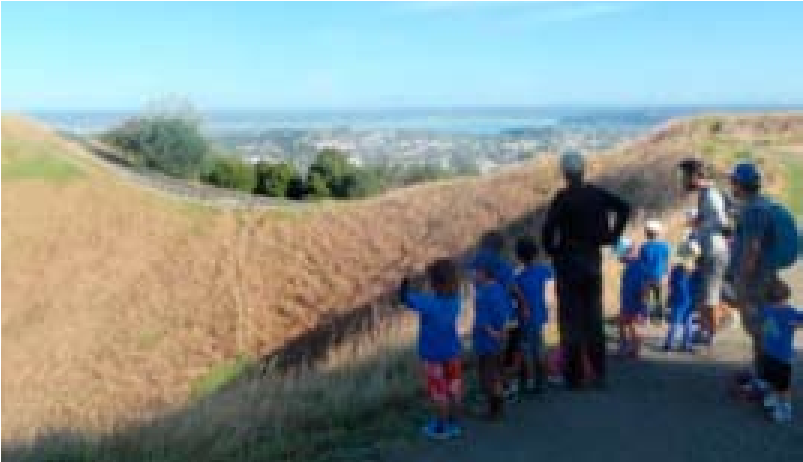 |
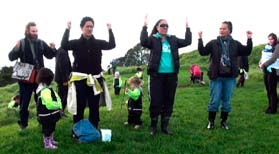 |
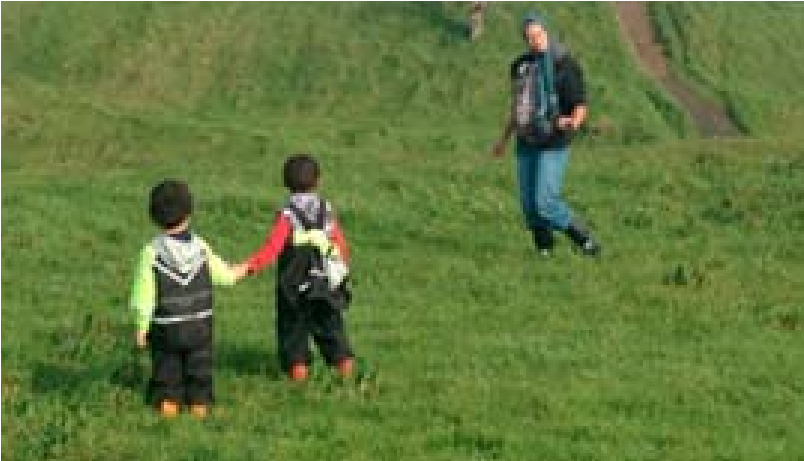 |
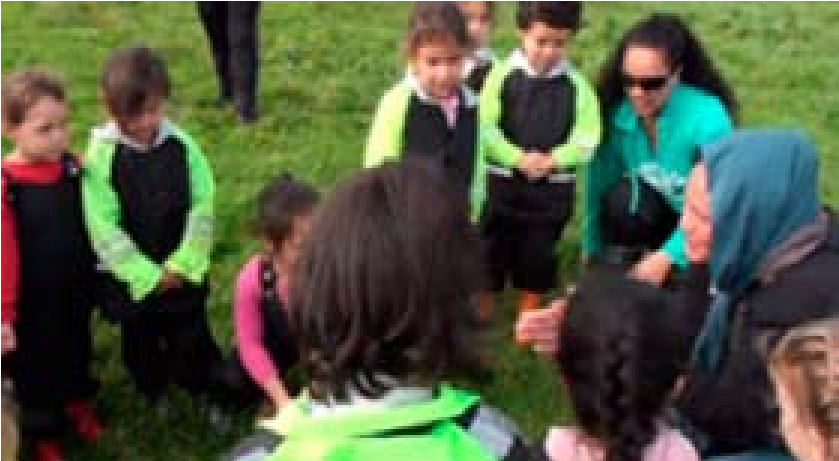 |
Te Puna Kōhungahunga on the Maungawhau hikoi
Te Puna Kōhungahunga decided with drama community artist, Molly, that their community event would be a performing arts hikoi up the mountain—which was a half hour walk from the centre. Maungawhau, as the mountain that children see from the centre daily, is key to the children’s collective emerging Māori identity, their sense of place in the here and now. Hence even when Maungawhau is not the mountain of their own whakapapa they wish to include it. (Whaea Lovey, personal communication, 30 April 2014). The journey would connect the spiritual “tide” of the mountain with the openness afforded by imaginative performing arts play. This was in keeping with the practice already established with the group but different in that they wanted to experience the journey to the mountain alongside performing arts experiences with the children. The event was envisaged as children and whānau climbing the mountain and stopping at stages to move into music, dance, and drama. Each stage became a resting place that created its own imaginative presence that was infused with potential for different performing arts learning opportunities. At one stop, up the mountain, several teachers and parents performed a Māori waiata with actions. The song became an entry point to the mountain, establishing a sense of connection. Further on the group enacted the Māori legend of Mataoho, named after one of the famous chiefs, and Mahuika—the goddess of fire. The cooking and fire play gave the children space to respond to an imagined historical world, a sense of another time that they could participate in, along with a sense of the gods and ancestors who lived on the mountain. Finally, at the top of the mountain, the group circled around the volcanic crater and chanted to each other across the acoustic void of the volcanic crater rim. The echoes bounded around the mountain, creating a musical ritual of sorts that embodied and played out the journey to the top.
Reflecting back on this community event, one kaiako described how they had felt something special taking place:
I just really lived the whole holistic experience for all of us, not just the tamariki … the biggest thing working on the hikoi walking performance, was ‘tangatawhenua’.[4] Yeah the tamariki really making those connections … Having that real connection to a cultural base here, not where they necessarily come from, but just where they’re located for the now, the here and now (Kaiako, Teacher reflection interview, 14 January 2014)
There were many other experiences felt in the movement and exploration that actualised on the hikoi: waiata, dancing that merged with the grassy environment, stick games, and numerous opportunities for other collective play. The planned underlying structure of this event was deliberately kept tentative due to the shared belief that what emerges “leaks” beyond the planning. This emergent practice was linked to the quality of flexibility. As Whaea Karen explained:
I always say flexibility is a great thing but you know actually that flexibility is the space in between. (Teacher reflection interview, 14 January 2014)
The mountain hikoi was a special community performing arts event that connected with the desires and beliefs of the centre children and community. The arts experiences, combined with the flexibility and openness of the teachers’ intentions, created a meaningful experience for those involved.
Sustainable practices: Helensville Montessori
Helensville Montessori decided their community event would be in the Helensville Town Hall. The event would be a way for the centre to reach out to the local community and share the life of the centre and its teachers and children through the performing arts. The teachers wanted to keep the experience “open” but also retain some sense of structure so it could be effectively managed. To this end, they decided to use the arts-based storybook Giraffes Can’t Dance[5] as a framework for various performing experiences to follow. The story was not shared with the children before the event so that the element of spontaneity was saved for the day itself. In preparation, the teachers and children partook in music, dance, and drama experiences that the teachers thought they would use, with the story as the special context on the day. This included developing animal movements with Adrian, bringing favourite jungle stories from home and sharing them at the centre, and singing and moving to the popular song The Lion Sleeps Tonight.
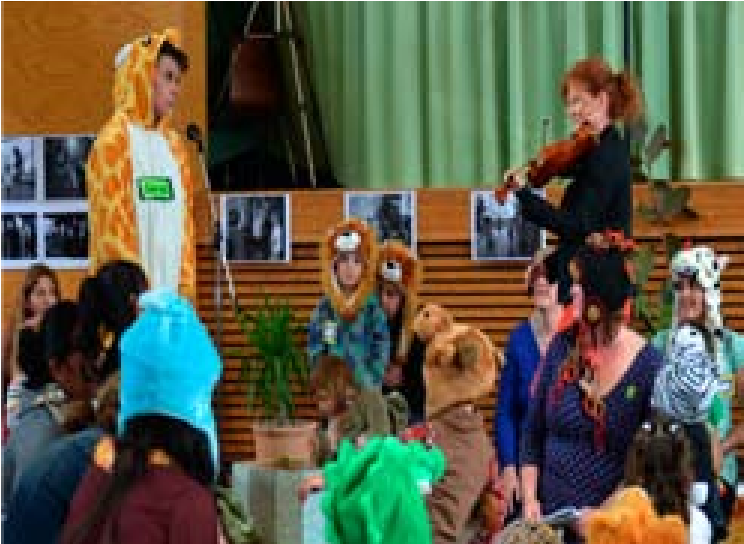 |
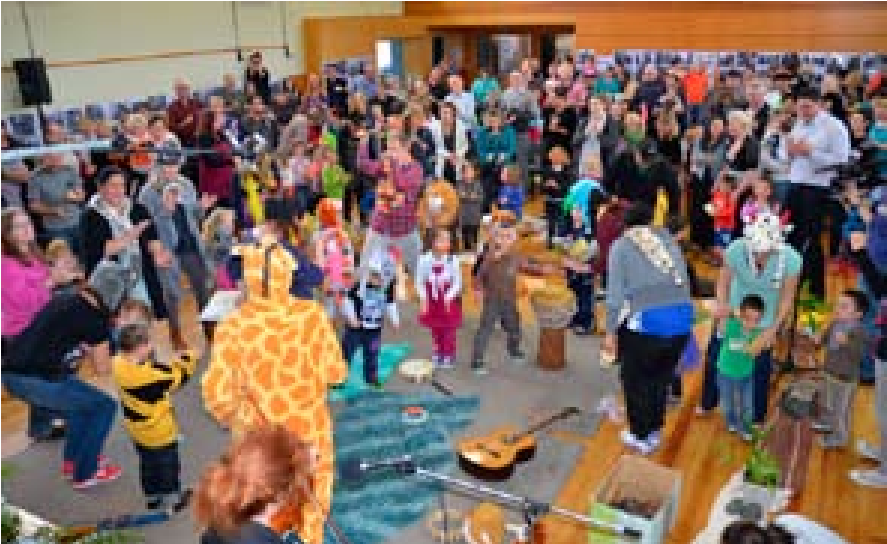 |
Helensville Montessori Town Hall event
On the event day parents and teachers brought along food to the town hall, and assisted with the set-up, which included 300 A3-sized black and white photos of the MAPS project, each carefully chosen for their depiction of the relationships with and between children (Teachers of Helensville Montessori, 2014, p. 63). Nicole, one of the teachers, took on the role of storyteller. This was a new experience for her, and later she reflected on what it felt like:
Leading up to the event I was very aware that process drama is quite a skill. Molly, our community artist, was fantastic and I knew she was quite extensively trained. This led me to wonder how I was going to achieve the role of storyteller. I was worried that I would not be able to set the scene, take direction from the children, use their ideas, validate what they would contribute and bring them back into the story if they went off track. (Teachers of Helensville Montessori, 2014, p. 66).
Despite Nicole’s initial concern the event was a great success and a celebration for the centre, mainly due to the support the teachers, parents, and community artists gave to each other, but also due to the range of exciting arts action: storytelling, mask making, movie watching, food preparation, face painting, movement, singing, and violin playing from a local community member who became the “fiddler” that features in the book.
Conclusion
The MAPS performing arts experiences in centres involved pedagogical processes that let children live their performing arts ideas for themselves, as a learning community. This came about through pedagogical strategies in music, dance, and drama that were experimental and improvisational (rhizomatic) in nature—strategies that had an element of structure, but also allowed for openness so that experiences could follow the children’s desires and interests. Community artists and teachers needed to be sensitive to children’s ideas and responses and give themselves permission to engage in and live the experiences for themselves. The teaching involved acts of caring, giving, receiving, and responding, and the particular qualities of music, dance, and drama afforded particular kinds of contexts for these actions. We found that this approach fostered a sense of inclusiveness and community in the experiences and brought about a more meaningful and authentic kind of performing arts understanding for the participants.
From a broader perspective, the research showed that performing arts teaching and learning could be sustained in centres if it involved parents and the wider community, but it needed time for teachers and parents to establish confidence. The performing arts provide much potential for meaningful community engagement, and performing arts events can bring a sense of community and togetherness to an early childhood centre and its environment. As a research intervention, MAPS showed that community artists can bring about successful change in performing arts teaching and learning in centres. Such intervention, however, needs to ensure careful attention is made to the ethos and culture of a centre and that the purpose and intention of the intervention is made clear. The formation of communities of learning through cluster days, community artist visits to early childhood centres, and the online Moodle created a responsive environment for the teachers to develop their passion for the performing arts. This provided a platform where change could be embraced, discussed, and questioned, and assisted in the sustainability of the programme. The MAPS project brought a level of reflexivity to performing arts teaching and learning in early childhood that enhanced the connectedness of experiences with centre environments, parents and the community.
Limitations
The research involved three case studies and the experiences as such cannot be generalised directly to other early childhood centres. However, there may be many synergies or potential links between the kinds of experiences that occurred in MAPS and the problems and issues other centres face day to day when teaching music, dance, and drama.
The study was limited to a certain time period for each performing art. In particular, all centres maintained that they would have appreciated more time developing skills and knowledge in the performing arts in more extended projects.
The centres who participated in the research all had an affinity with Reggio Emilia practices and ideas. As such, it was a targeted study for centres with a particular interest in the arts and community.
Footnotes
- The MAPS project worked with Awhi Whānau Early Childhood Centre for one term but this centre had to withdraw and Te Puna Kōhungahunga joined at that stage. ↑
- While performing arts work with children was always a focus of the study, the research outcomes reflected the voices of the teacher participants in this particular project. ↑
- See the Make Believe Arts website at http://www.makebelievearts.co.uk and Gussin Paley, V. (1990). The Boy Who Would Be Helicopter. Cambridge, MA: Harvard University Press. ↑
- Tangata means people and whenua means land. Tangatawhenua references the unique relationship Māori have with the land, with place, and with connecting and belonging to a place. ↑
- Andreae, G., & Parker-Rees, G. (1999). Giraffes can’t dance. London: Orchard Books. ↑
References
Bresler, L. (2010). Ethnography, phenomenology and action research. Visions of Research in Music Education, 16(6). (Reprinted from The Quarterly Journal of Music Teaching and Learning, 1995, 6(3) 4–16.) Retrieved from: http://www-usr.rider.edu/~vrme/v16n1/volume6/ visions/fall2
Csikszentmihalyi, M. (1996). Creativity: Flow and the psychology of discovery and invention. New York: HarperCollins.
Dahlberg, G. (2012). Pedagogical documentation: A process for negotiation and democracy. In C. Edwards, G. Forman, & L. Gandini, (Eds.), The hundred languages of children: The Reggio Emilia experience in transformation (pp. 225–232). Santa Barbara, CA: Praeger.
Dahlberg, G., & Moss, P. (2006). introduction: our Reggio Emilia. In C. Rinaldi (Ed.), In dialogue with Reggio Emilia: Listening, researching and learning (pp. 1–22). London & New York: Routledge.
Deleuze, G., & Guattari, F. (1987). A thousand plateaus: Capitalisms and schizophrenia (B. Massumi, Trans.). London: University of Minnesota Press.
Duhn, I. (2012). Places for pedagogies, pedagogies for places. Contemporary Issues in Early Childhood, 3(2), 99–107.
Ellingson, L. (2009). Engaging crystallization in qualitative research: An introduction. London: Sage.
Fraser, D., Price, G., & Aitken, v. (2007). Relational pedagogy and the arts. set: Research Information for Teachers, 1, 42–47.
Lenz Taguchi, H. (2010). Going beyond the theory/practice divide in early childhood education: Introducing an intra-active pedagogy. New York: Routledge.
Naughton, C. & Lines, D. (2013). Developing children’s self-initiated music making through the creation of a shared ethos in an early years music project. Australian Journal of Music Education, 1, 23–34.
Ministry of Education. (1996). Te whāriki: He whāriki mātauranga mō ngā mokopuna o Aotearoa: Early childhood curriculum. Wellington: Learning Media.
Olsson , L. (2009). Movement and experimentation in young children’s learning: Deleuze and Guattari in early childhood education. New York: Routledge.
Pohio, L. (2009). Reggio Emilia pedagogy in early childhood education: How can this approach enhance visual arts experiences in New Zealand? He Kupu, 2, 10–18.
Richardson, L., & St Pierre, E. A. (2005). Writing: A method of inquiry. In N. K. Denzin & y. S. Lincoln (Eds.), The handbook of qualitative research (pp. 923–49). Thousand Oaks, CA: Sage.
Rinaldi, C. (2001). A pedagogy of listening. Children of Europe, 1, 2–5.
Ritchie, J. (2012). Early childhood education as a site of ecocentric counter-Colonial endeavor in Aotearoa/New Zealand. Contemporary Issues in Early Childhood, 13(2), 86–98.
Sanger, P. (2003). Living and writing feminist ethnographies. In R. Clair (Ed.), Expressions of ethnography: Novel approaches to qualitative methods. New York: State University of New York Press.
Sansom, A. (2011). Movement and dance in young children’s lives: Crossing the divide. New York: Peter Lang.
Sellers, M. (2013). Young children becoming curriculum. London: Routledge.
Teachers of Helensville Montessori. (2014). Moving, acting, playing and singing: Teaching and learning performing arts with young children. Helensville: Grimstock Publishing.
Conference presentations and publications
Durham, H., & Paulsen, N. (2013, November). MAPS. Keynote address at the New Zealand Tertiary College Research Conference, Greenlane, Auckland.
Liley, K., AhChee, D., Paulsen, N., Nomani, F., Andrews, L., & gates, J. (2012, November). Being in the arts: Putting the theory into action: A study in active arts participation. Symposium presentation at the NZARE Early Childhood Research Hui, Hamilton.
Lines, D. K. (2012, July). Mapping community music work: A rhizomatic approach. In D. Devito (Chair), international Society for Music Education Commission for Community Music Activity international seminar, Ionian University, Kerkira, Greece.
Lines, D. (2013, December). Deleuze and the ocean swimmer: Relationality and early childhood arts learning. In D. Lines (Chair) Negotiating the emergent terrain of the arts early childhood research symposium. Symposium conducted at the Philosophy of Education Society Australasia (PESA) annual conference, University of Melbourne.
Lines, D. (2014, April). ocean swimmer: Metaphor and the arts in early childhood. Paper presented at the Disrupting by imagining: Rethinking early childhood research symposium. Symposium conducted at the American Educational Research Association conference, Philadelphia.
Lines, D., Roder, J., & Naughton, C. (2012, November). Move, Act, Play, Sing (MAPS): Community artists working with children in early childhood centres. Symposium presentation at the NZARE Early Childhood Research Hui, Hamilton.
Lines, D., Roder, J., Naughton, C., Matapo, J., Liao, T., Whyte, M., … & AhChee, D. (2012, November). Move, Act, Play, Sing (MAPS). In C. Naughton (Chair), Keeping the arts in play symposium. Symposium conducted at the New Zealand Tertiary College conference, Greenlane, Auckland.
Matapo, J., & Roder J. (2014). MAPS: Living, moving, emerging assemblages. He Kupu, 3(4), 39–53.
Matapo, J., & Whyte, M. (2013, November). “Keeping the Arts in Play”: An interim report on the TLRI Move, Act, Play, Sing (MAPS). Paper presented at the New Zealand Association for Research in Education annual conference, Dunedin.
Naughton, C. (2012, July). Re-evaluating educational practice through the encounter with philosophy: The case of early childhood music education. Seminar presented at the University of Exeter EdD summer school, Exeter, UK.
Naughton, C. (2013, December). “They won’t be measuring anything … so what are the goals and purpose of the study?” A reflection on the philosophical terrain of Move, Act, Play Sing (MAPS). Paper presented at the Negotiating the Emergent Terrain of the Arts Early Childhood Research Symposium. Symposium conducted at the Philosophy of Education Society Australasia (PESA) annual conference, University of Melbourne.
Naughton, C., & Lines D. (2012, July). Developing collaborations with the potential to reveal new learning experiences and understandings of process and practice in music education. Paper presented at the international Society of Music Education conference, Thessaloniki, Greece.
Naughton, C., & Lines, D. (2013). Developing children’s self-initiated music making through the creation of a shared ethos in an early years project. Australian Journal of Music Education, 1, 23–34.
Naughton, C., Lines, D., & Liao, T. (2014). “…actually, with music, it just happens”: interpreting signs within music in a performance arts based project and MAPS. He Kupu, 3(4), 54–66.
Naughton, C. (Chair), Hunter, M. A., Ewing, R. (2012, December). Keeping the arts in play. Symposium conducted at the Australian Association for Research in Education conference, Sydney.
Naughton, C. (Chair), Mcfarlane, K., Nolan, A., & Lewis, T. (2013, December). Building our communities in early childhood education: Invited symposium. Invited symposium conducted at the Australian Association for Research in Education conference, Melbourne.
Roder, J. (2013, December). Deleuze’s assemblages of desire: Mapping desiring machines that speak to arts-based learning in early childhood settings. In D. Lines (Chair) Negotiating the Emergent Terrain of the Arts Early Childhood Research Symposium. Symposium conducted at the Philosophy of Education Society Australasia (PESA) annual conference, University of Melbourne.
Teachers of Helensville Montessori. (2014). Moving, acting, playing and singing: Teaching and learning performing arts with young children. Helensville: Grimstock Publishing.
Whyte, M., & Matapo, J. (2012, November). The arts outside the box: Promoting meaning making in an emergent learning environment. Symposium presentation at the NZARE Early Childhood Research Hui, Hamilton.
Whyte, M., Matapo, J., & Liao, T. (2013, November). Move, Act, Play, Sing (MAPS). Paper presented at the New Zealand Tertiary College research conference, Greenlane, Auckland.
Whyte, M., & Naughton, C. (2014). “What’s our next move”: Seeing children in the light of potentialities. He Kupu, 3(4), 28–38.

